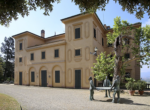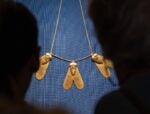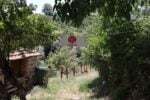Rituals of Paper 1981-1995
.jpg)
Martin Disler è un importante scrittore, pittore, scultore e disegnatore senza fine. Le sue opere su carta sono geneticamente l’inizio dei suoi lavori di grande formato; nel gesto su carta egli trova, dandole forma, quell’energia poetica, che trasmette potenza ai suoi lavori più grandi.
Comunicato stampa
Dopo la sua mostra nel 1994 a Castelgrande (sculture bronzee) e nella prima sede del Centro d’Arte (opere murali) – con la quale il MACT/CACT inaugurò la sua apertura ufficiale in Ticino – e quella del 2014, a commemorare i vent’anni da questo primo evento, il nostro Istituto ospita il terzo incontro espositivo con Martin Disler (1949-1996); questa volta interamente dedicato all’opera su carta.
L’energia fortemente prolifica dell’artista svizzero spazia da tecniche e linguaggi molto diversi tra loro, anche se un comune denominatore li unisce; il notevole vigore creativo, che attraverso la violenza del gesto espressivo dell’espressione stessa, riesce a perforare la dimensione reale, costringendo lo spettatore a mettersi a confronto con il fastidioso piacere delle proprie ossessioni esistenziali, che pure sono quelle dell’umanità intera.
Martin Disler è un importante scrittore, pittore, scultore e disegnatore senza fine. Le sue opere su carta sono geneticamente l’inizio dei suoi lavori di grande formato; nel gesto su carta egli trova, dandole forma, quell’energia poetica, che trasmette potenza ai suoi lavori più grandi. La carta è, per l’artista, quel corpo ch’egli sfiora talvolta con grazia, talvolta con incisa violenza. L’impatto tra la forte rappresentazione dei suoi corpi in continua metastasi e riproduzione e la delicatezza cartacea dà un senso alle sue scelte tematiche e di vita. Disler è un autore al di là delle convenzioni sociali, oltre la vita stessa, e soprattutto consapevole della natura secolare del transito e passaggio metamorfico tra la nascita e la morte: questa difficile ritualità sempre in bilico e disperatamente in dialogo con l’Infinito.
Non solo disegnatore, ma anche incisore sconfinato, con una produzione che contempla quasi tutte le tecniche calcografiche, Martin Disler segue e rispetta – come un pianista davanti al suo strumento – i suoi temi e nell’istesso tempo la tecnica che ha scelto per dare loro un corpo. Il corpo, il continuo rapporto con l’altro e con il sé sono, infatti, le liturgie dell’uomo e i temi fondamentali del processo creativo di questo autore.
In mostra si riassumono tutti i periodi della sua corta ma intensa carriera; dai primi anni Ottanta fino al 1995, anno che precede la sua prematura scomparsa. In questa nuova e ultima fase della sua produzione artistica, Martin Disler sviluppa maggiormente i temi con rinnovata poetica espressiva, rispetto allo stilema che lo ha contraddistinto e marcato negli anni Ottanta.
La dimensione della mostra è “da camera”, non foss’altro che per formato delle opere, e riassumono parallelamente il gusto di chi le ha assemblate. Il gesto disleriano graffia la superficie della carta, la incide, la scolpisce e talvolta la mortifica, come fosse una materia dura, cui attribuire un senso e dare un’anima morbida.
Le xilografie del 1988, per esempio, stampate su di una fine carta giapponese, mal celano la notevole forza fisica dell’artista mentre prepara la tavola lignea. Il suo gesto muscolare nell’atto esecutivo è in seguito riprodotto con grazia e delicatezza sulla base cartacea, così come per le tecniche miste, l’autore mette a dura prova quel delicato supporto, mettendosi altresì alla prova con piacevole incoerenza e desiderio di sperimentazione e ricerca.
La grandezza di Martin Disler riposa nel dialogo con l’Infinito e nel superamento della barriera reale per varcare quel portale dell’universalità che lo rende magistrale ed eterno.
L’esposizione è un omaggio a uno degli artisti svizzeri, che hanno tracciato in qualche modo anche la Storia e le storie di questo Centro. Il suo autoritratto, Gerinnendes Selbst (Il Sé che si coagula) del 1987, rimane uno dei suoi pezzi per noi importanti, capace di trasformare l’artista che ritrae il sé in una forza della natura; quella che oltrepassa l’oggettivo per fondersi con l’universo, lo sciamanico o il sovrumano.
La ritualità in Disler, che è anche ossessività produttiva e quindi ossessione del trasmettere il proprio sé, tocca momenti estatici tali, da ricordare quella follia dei body artisti, intenzionati a lasciare il corpo oggettivo e soggettivo per entrare quasi nel soprannaturale, all’interno di una dimensione fondamentalmente anti-culturale.
Mario Casanova, 2018.
MACT/CACT Arte Contemporanea Ticino è sostenuto finanziariamente e culturalmente da Repubblica e Cantone del Ticino/Swisslos, Alfred Richterich Stiftung Kastanienbaum, Città di Bellinzona, Amici e Sostenitori del MACT/CACT, da Collezionisti e Artisti.
After the exhibition he held in 1994 in Castelgrande (bronze sculptures) and in the first home of the Art Centre (mural works) – which inaugurated the official launch of the MACT/CACT in Ticino – and the subsequent one held in 2014 to commemorate the twentieth anniversary of the first event, our Institute is now pleased to host a third exhibition and meeting with the works of Martin Disler (1949-1996). This third event is devoted entirely to his works on paper.
The fields interested by this Swiss artist’s singularly prolific energy cover a highly differentiated range of techniques and idioms, although they are united by a common denominator: through the violence of the expressive gesture of his expression itself, his incredible creative vigour succeeds in piercing through the dimension of reality, obliging the observer to face up to the irksome pleasure of his own existential obsessions, which he shares with humanity as a whole.
Martin Disler was an important writer, painter, sculptor and a tireless creator of drawings. Genetically speaking, his works on paper mark the beginning of his achievements in large formats. In his gesture on paper, he found and gave form to that special poetic energy that conveyed potency to his largest works. For this artist, paper was the body he would brush up against, sometimes gracefully, sometimes with unmitigated violence. The impact between the vigorous representation of his bodies in continuous metastasis and reproduction and the delicacy of the paper support gave meaning both to his choices of topics and to his life choices. Disler was an author who went beyond social conventions, beyond life itself, and above all one who was aware of the secular nature of the metamorphic passage and transit between birth and death, the arduous ritual forever balanced on a knife-edge and desperately dialoguing with infinity.
Not only did he draw: his work in etching also knew no bounds, generating an output that tackled practically all techniques of engraving. Like a pianist seated at his instrument, Martin Disler followed and complied with his topics and, at the same time, the technique he chose to give them a body. That body and the continuous relationship with self and with otherness are, in fact, man’s liturgies and the issues fundamental to this author’s creative process.
The exhibition sets out to summarise all the periods of the artist’s short but intense career, from the early eighties to 1995, the year before his premature death. In this new and last phase of his artistic output, Martin Disler developed further on his themes with renewed expressive poetry compared to the stylistic approach that had been his distinctive hallmark in the eighties.
The dimension of this exhibition is that of a ‘chamber’ display, if for no other reason, then because of the format of the works, which at the same times also speaks about the taste of their assembler. Disler’s graphic gesture scratches the surface of the paper, cuts and sculpts it and sometimes mortifies it, as though it were a hard material in need of being given a meaning and a soft soul.
His 1988 woodcuts, for example, are printed on a fine Japanese paper and barely conceal the notable physical force exerted by the artist while preparing the wooden block. His muscular gesture in the act of execution was subsequently reproduced with grace and delicacy on the paper support, just as, when using mixed techniques, the artist subjected that delicate support to tough treatment, while also putting himself to the test with attractive inconsistency and an urge to experiment and research.
Martin Disler is singled out for greatness by his dialogue with infinity and his intent to break through the barrier of reality so as to step over the threshold of universality that made him masterful and eternal.
This exhibition is a tribute to one of the Swiss artists who contributed in one way or another to writing the history of this Centre and the stories that go with it. His 1987 self-portrait, Gerinnendes Selbst (Coagulating Self), is still today one of his most important pieces for us, with its ability to transform the artist who portrays the self in a force of nature: that which goes beyond the objective dimension to meld with the universe, the world of the shaman or of the superhuman.
Rituality in Disler, which is also the obsession to produce and thus the obsession to transmit himself, achieved such moments of ecstasy as to remind us of the folly of body artists who set out to abandon their objective and subjective body, so as to enter almost into the supernatural, in a dimension that is fundamentally anti-cultural.
Mario Casanova, 2018
Translation by Pete Kercher
MACT/CACT Arte Contemporanea Ticino enjoy the financial and cultural support of the Republic and Canton of Ticino/Swisslos, the Alfred Richterich Foundation Kastanienbaum, the City of Bellinzona, Friends and Supporters of MACT/CACT and by Collectors and Artists.



